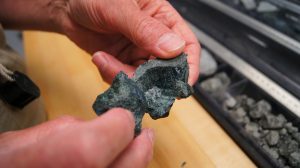Should We Stay or Should We Go?
There comes a time toward the end of the expedition where things can spin on a dime from having lots of time to not having enough. After the second bit change we were bringing up loads of rocks- sometimes recovering 70 percent. We were making progress toward drilling a column of rocks that would overlap with the rocks in the previous site to discover how this subduction zone was layered. In the last few days, things got a little wacky- crumbly rock and not much of it.
When it was time to pull up the pipe today to exchange the bit with one that can cut better in this harder formation (we are already more than 1500 feet deep), we found ourselves stuck at the bottom. Several hours of yanking on the drill string didn’t do much. So the dreaded option arose: we would have to use explosives to blow up about 400 feet of the pipe still in the hole, signaling the end of this hole.
As this prospect loomed, the crew cranked up the pounds of pulling force from 130,000 to 190,000 pounds. This effort managed to free the bottom of the drill string, albeit very slowly. Within the hour, the plan had changed again.
Now came the question— do we stay in this hole and try to go deeper, or do we move on? After all, we had not recovered all the rocks the team wanted, namely the forearc basalt. And if we move to another hole, it’s still a gamble whether we can find the layers that will bridge the two sites.
So the group voted on whether to stay here, since we are so close to achieving the objective. Some were not convinced we should move on, and suggested trying to cement the problematic section of the hole, but that option was too risky, since we have entered a fracture zone. When cleaning the hole, the cuttings and fluid seem to be disappearing into the fault’s cracks and crevices instead of being spewed out the top. Thus, the same cuttings probably fall into the hole when we stop circulation. It would be a challenge to cement the sides if the fluid flows away before it can solidify.
On the other hand, we don’t have enough time on board to make an entire reentry system for a new hole. We have a free fall funnel to help us reenter the hole, which means no casing, and approximately two bit changes before the cone almost disappears into the mud. There’s no guarantee we’ll get to what we need at that hole or that we wouldn’t encounter a fault there, too. However, in this deeper site they hope to reach this elusive layer of rocks quicker. The idea is to use a certain bit, which isn’t ideal for the sedimentologists, but a good compromise to ensure a more rapid descent to the “basement”. We will be working against a tight agenda of about two weeks.
“It’s a bit of a ‘loggery’ either way,” jokes Sally, our logging scientist.
It goes to show that even when things are looking, up, they can turn sour in an hour.
